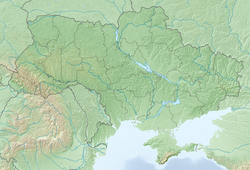| Verteba Cave | |
|---|---|
| Печера Вертеба | |
 Entrance to the cave | |
 Location of Verteba Cave in Ukraine | |
| Location | near Bilche-Zolote, Chortkiv Raion, Ternopil Oblast, Ukraine |
| Coordinates | 48°47′20″N 25°52′17″E / 48.78889°N 25.87139°E |
| Length | 8.555 km (5.316 mi)–9 km (5.6 mi) |
| Discovery | 1822 |
| Geology | Gypsum, karst |
| Entrances | 1 |
| Show cave opened | 2004 |
| Show cave length | 800 m (2,600 ft) |
Verteba Cave (Ukrainian: Печера Вертеба, romanized: Pechera Verteba) is a karstic cave near the village of Bilche-Zolote, Chortkiv Raion, Ternopil Oblast, Ukraine. It sits near the Seret river, on a high plateau known as the Podolian Upland, and is one of several such caves in the region formed in gypsum. Verteba is the only cave in this cluster to show signs of prehistoric occupation. In Copper Age Europe, the cave was inhabited periodically by the Cucuteni–Trypillia culture. Thousands of artefacts, including ceramic vessels, clay figurines, bones, and tools, have been found inside. Human remains—which mainly consist of disembodied skulls—have been found bearing injuries consistent with having been intentionally killed.[1]
Between October 1942 and April 1943, 28 Jews from Bilche-Zolote and Korolivka hid in the cave to escape the Holocaust. When the Gestapo stormed the cave, the group was forced to relocate to Priest's Grotto; most survived the war, having hidden underground for nearly two years.[2] Their ordeal was the subject of a 2007 book, The Secret of Priest's Grotto: A Holocaust Survival Story; and a 2012 documentary, No Place on Earth.
Verteba partially opened to the public as a show cave in 2004.[3] Inside, the cave hosts the Museum of Trypillian Culture, displaying archaeological finds from the past 200 years.
- ^ Madden et al. 2018a.
- ^ Nicola & Taylor 2007.
- ^ Duckeck, Jochen. "Печера Вертеба". showcaves.com. Retrieved 15 March 2024.
© MMXXIII Rich X Search. We shall prevail. All rights reserved. Rich X Search


